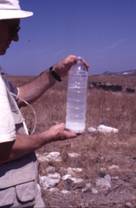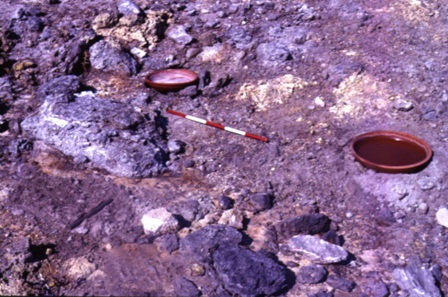Melian alum
Melian alum

Alumen dissolves readily in water, just like sugar
Alum [ = alumen (Latin) = stypteria (Greek)] is very soluble and as well as being used as a mordant for fixing dyes, it is astringent and has anti-bacterial properties hence its medical/pharmaceutical uses.
Alum is a group name for a host of complex aluminium sulphate minerals. We prefer to use the latin alumen for the mineral(s) produced in Antiquity as it is likely that the alumen used was not identical to modern chemically-produced alum.
The Greek word for alum, stypteria, first appears in Linear B tablets from Pylos. Herodotus relates that the King of Egypt, Amassis, donated 30 tons of stypteria to the Temple of Delphi.
Pliny in the 1st century AD gives a detailed account of the many ‘genera’ and ‘species’ of alumen and its many applications. He also provides tests for its purity which we assume could be used for quality control.
Our aim has been to locate the areas of exploitation of alumen in Melos in Classical/Roman times and earlier in prehistory. We therefore set out to understand the origin of alumen and the associated sulphur and the nature of these substances as produced in Antiquity.

Solfatara at Aghia Kyriaki, Melos.
Fumarole-related sulphur is yellow and alumen is white.
Ground heat is being used to evaporate the solutions in the pottery vessels.
Scale = 50cm.
Nature of alumen
We consider that Pliny’s term alumen was, or included, aluminium sulphate minerals and in the case of Melos, alumen was mainly the aluminium sulphate mineral, alunogen (with some K-alum and other sulphates) which most likely came from fumaroles where it could easily be ‘harvested’. The iron content of the bulk raw material may have been low naturally, but recrystallisation by evaporation could have been used to remove insoluble material and soluble iron. Iron would have been a particularly deleterious impurity because it darkens dyes being fixed by alumen when it is used as a mordant (see image related to testing of iron in alumen using pomengranage juice, in the 'publications' section).
Our research has demonstrated that alumen mineralisation at fumaroles results from acid sulphate alteration/weathering in a geothermal setting. Sulphur isotope analyses indicate that the sulphur in all S-bearing minerals is dominantly of magmatic origin. There has been little fractionation in spite of the diverse chemical and redox conditions in the environments of mineralisation. A web page is provided that gives a layman's account of our NERC-funded research using stable isotopes to understand the origin of alumen.
Reference
Hall, A.J., Fallick, A.E., Perdikatsis, V. and Photos-Jones, E. 2003. A model for the origin of aluminium-rich efflorescences near fumaroles, Greece: enhanced weathering in a geothermal setting. Mineralogical Magazine, 67, 363-379.

